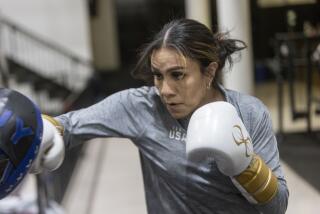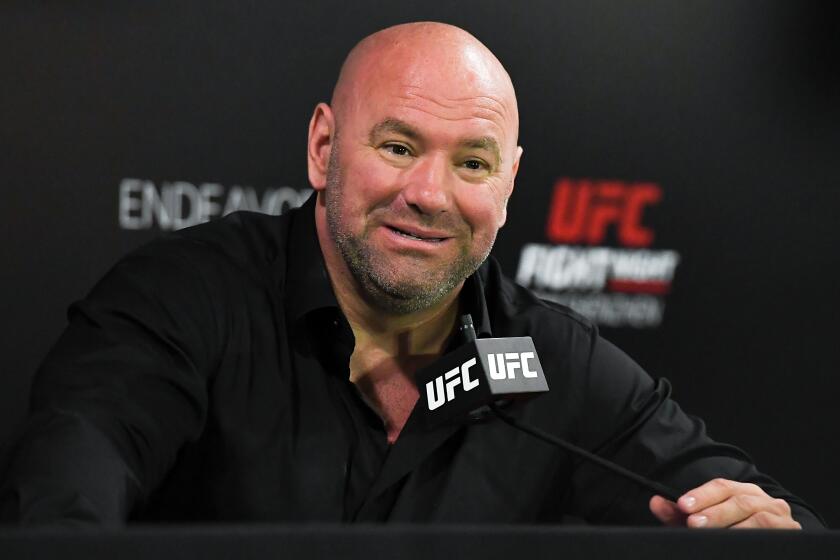Three Times Now Has Charm
Time was when, to get somewhere in the fight game in this country, a pug had to take a run up to arenas in Pittsfield or Holyoke, Mass., take on a trial horse or two, win big, then climb into two dozen rings in tanktowns and learn his craft in a slow, painstaking way.
Itâs the way they all started. Some padded their records by fighting their chauffeurs or even members of their family. Marciano fought his brother in Maine. Dempsey hoboed around on the bottom of freight cars and took part in saloon fights and lodge smokers until Doc Kearns took him in tow. Joe Louis started out belting out the likes of Jack Kracken, Alex Borchuk and Art Sykes and other third-raters until somebody dubbed him the Brown Bomber and brought the act to New York.
There were no shortcuts. You left-hooked your way to the top in grimy little fight clubs, on the undercard, often for a payoff in cheap watches or bouncing checks. Archie Mooreâs first two fights were with Piano Man Jones and Kid Pocahontas, to give you an idea. He had 234 fights in all in his climb to the top.
That has changed. Since World War II, pugs have found the way to instant fame without the hard, grinding groundwork: the Olympics.
Before the war, an Olympic champion was not that big a star. A better-than-average featherweight, Fidel La Barba, achieved some renown. He parlayed an Olympic championship into a couple of title shots, but that was because he practiced his trade mostly in the arenas around Hollywood, where he became the darling of the movie colony, a favorite of, among others, Charlie Chaplin, whose fascination with the ring game resulted in some of his funniest scenes.
Floyd Patterson was probably the first to turn a gold medal into a gold mine. Patterson was the first Olympic champion to become world champion. The interesting leap was, he was the Olympic middleweight champ who became the worldâs heavyweight champ.
Muhammad Ali was the second. If you look in the record books, you will see a young fighter named Cassius Clay listed as the Olympic light-heavyweight champ in 1960. He not only became world champ, he became Muhammad Ali.
It has become rather commonplace. Sugar Ray Leonard came out of the Games. So did Evander Holyfield, George Foreman, Joe Frazier and both the Spinks brothers, Leon and Michael. Leon traded on his Olympic record to become heavyweight champion in only his eighth professional fight. Michael took a little longer to win his title.
At first, you have to bang yourself on the side of the head when you receive an invitation to attend a special lunch at a posh Beverly Hills restaurant for a fighter who has had--count âem!--a total of three professional fights.
Ordinarily a guy who has had three professional fights would be parking cars at a posh Beverly Hills restaurant, not being guest of honor in one.
But Oscar De La Hoya is no ordinary pug. He is the only American to have won an Olympic gold medal in the recent Games at Barcelona. He is Instant Contender.
A pair of entrepreneurs have already paid him a million dollars for the rights to one-third of his purses. Cable TV has bought into the action. There is talk of a De La Hoya fight headlining the opening of the new MGM flagship hotel in Las Vegas.
De La Hoya is already a star. The promoter, Bob Arum, has already taken him under his wing. His career is as carefully plotted as an invasion of the Low Countries by the German general staff.
The question is, will it work? It worked for Ali, it worked for Leonard. On the other hand, it didnât work for Paul Gonzales. Paul was the darling of the 1984 Olympics who got backing, engaged in a few widely scattered, desultory fights--and drifted back into oblivion.
The fight game is betting it wonât happen to De La Hoya. The decision is his. Now that he has his million, does he want to bleed for it? Take blows to the head? Find himself in the ring with some local tough whose style is an enigma to him? Spend the endless hours in conditioning that this cruel science requires?
De La Hoya is a charismatic athlete. He has the clean-cut, boy-next-door look about him of a movie pug. He doesnât curse or hang out in bars. He runs six miles a day. He dedicated his gold medal tearfully to his late mother, who died before she could see all her sonâs hard work pay off in Barcelona. Nick Nolte doesnât get the part.
His appeal can be international. Mexico City follows his fights as avidly as Los Angeles.
But can he fight? Arum, who was in on the original Leonard promotion, says he can be as good as that Olympian or any other.
âHe has hand speed, foot speed, he hits hard with either hand. I think heâll surpass Leonard. Heâs bilingual, his attraction is universal. Heâll draw.â
De La Hoya insists he will not take the money and run. âMy goal is to unify the (lightweight) title and be the best champion I can be,â he says. âI want kids in the barrio to look up and say, âHey, De La Hoya can do it, I can do it!â Iâm not saying Iâll fight for 10 years, but I may for five, six or seven.â
He plans to fight for a title as early as December. He has had only three fights to date, notably against opponents who not only had to be carried out of the ring, they had to be helped into it. âPalookasâ would be a kind description.
Dempsey had 73 fights before he got a title shot. Sugar Ray Robinson had 76. De La Hoya might barely break double digits. âBut Iâve had 232 fights since I was 10 years old,â Oscar insists. âIâve taken some shots. I remember when I was 16 years old I was in with this Russian who was 28 years old. I have had scary moments.â
If you are already giving media lunches before you have fought a 10-rounder, he is asked, how can you be a hungry fighter? De La Hoya smiles. âYou can be hungry for something besides food. âOlympicâ champion sounds nice. âWorldâ champion sounds better.â
More to Read
Go beyond the scoreboard
Get the latest on L.A.'s teams in the daily Sports Report newsletter.
You may occasionally receive promotional content from the Los Angeles Times.










